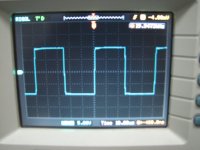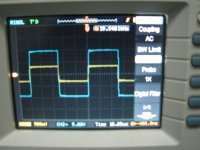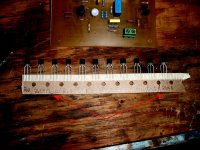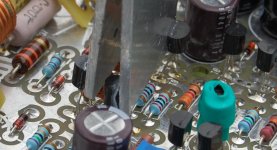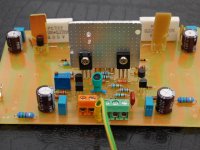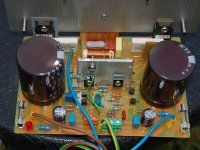Hi Farl
Did you test your amp with square wave ?
you do hear some noise-hum?
Ηow many seconds activates the relay output to your amp?
What output transistors using?
Good job.
If you mean noise/hum inside the amp, It's dead quiet, i didn't connect to the speaker yet.
Relays activate a 8 seconds
Transistor: BUZ900 & 901 perfectly matched
DC offset stable at +/- 2mV
No source resistor.
T11 and T12 normal temp after one hour.
For the square wave, input yellow....
Farl
Attachments
Maybe OS meant: "The term anal retentive (also anally retentive), commonly abbreviated to anal, is used conversationally to describe a person who pays such attention to detail that the obsession becomes an annoyance to others." (from Anal retentive - Wikipedia, the free encyclopedia)
Maybe OS meant: "The term anal retentive (also anally retentive), commonly abbreviated to anal, is used conversationally to describe a person who pays such attention to detail that the obsession becomes an annoyance to others." (from Anal retentive - Wikipedia, the free encyclopedia)
Thanks for the explanation SmartX21, Sorry OS I though it was a new past time activity with close friends
(The post was meant to be a little light sarcasm)
Last edited:
Thanks for the explanation SmartX21, Sorry OS I though it was a new past time activity with close friends
(The post was meant to be a little light sarcasm)
No prob , Nico. Most input pairs can be done as (below) , with simple DMM Hfe reading written on the "strip" . Those fairchilds were 259 -265 Hfe with 90 out of the strip of 100 candidates for input pairs. Current mirrors also benefit from this basic matching. Of course , build the circuit and CRO a curve trace to be truely "anal" ... but I have only seen this level of matching done on analog voltage controlled filters and oscillators ( ARP/Moog sythesizers). Most single ended amps .. this one or any "blameless" style , will do <1mv regardless. If it does not , there is another issue
OS
Attachments
Goldmund Clone listening impression
After few days of listening, all I can say that this amplifier produce a very clean, detailed and no harsh on top end. When I connected it to my Sonus faber clone (book shelve) it gives a very detailed sound but less in bass. But when I connected it to my watt puppy clone it shines everything. The bass is very tight and cool while the clean and detailed of the music is still there. For me this amplifier is good for floorstanding speaker.
I’d compared it side by side to my Leach amp, Krell KSA50 and Audio Research VT60 (all clone). The GM is the winner, GM outperform my long time favorite Krell KSA50 clone.
This is a very sensitive amp. The sound was distorted when if I increased the volume when I’d connected it to my Mcintosh C22 pre (clone) that has a DC output. But when I connected it to my Audio Research LS8mk2 (clone) with zero DC offset, everything works great.
The DC offset at the speaker terminal before playing music is +/-3mv but when i start playing it is jumping to +/-15mv, I think this is still acceptable.
For me Nagy’s is correct,
“The Very Best Amplifier I Have Ever Heard”
After few days of listening, all I can say that this amplifier produce a very clean, detailed and no harsh on top end. When I connected it to my Sonus faber clone (book shelve) it gives a very detailed sound but less in bass. But when I connected it to my watt puppy clone it shines everything. The bass is very tight and cool while the clean and detailed of the music is still there. For me this amplifier is good for floorstanding speaker.
I’d compared it side by side to my Leach amp, Krell KSA50 and Audio Research VT60 (all clone). The GM is the winner, GM outperform my long time favorite Krell KSA50 clone.
This is a very sensitive amp. The sound was distorted when if I increased the volume when I’d connected it to my Mcintosh C22 pre (clone) that has a DC output. But when I connected it to my Audio Research LS8mk2 (clone) with zero DC offset, everything works great.
The DC offset at the speaker terminal before playing music is +/-3mv but when i start playing it is jumping to +/-15mv, I think this is still acceptable.
For me Nagy’s is correct,
“The Very Best Amplifier I Have Ever Heard”
Last edited:
Farl
Congratulations with your Golmund clone.
Your listening results match very well with what I have experienced.
Like you, I had the opportunity to directly compare the Goldmund
with three other amps: The End mk 3.1, a modified Musical Angel 845 and a NP F4/Aikido. All these have their strengths.
Goldmund combine in many ways the good qualities of all three.
What about some pictures, Farl?
Who is the next one out with their building results??
Eivind Stillingen
Congratulations with your Golmund clone.
Your listening results match very well with what I have experienced.
Like you, I had the opportunity to directly compare the Goldmund
with three other amps: The End mk 3.1, a modified Musical Angel 845 and a NP F4/Aikido. All these have their strengths.
Goldmund combine in many ways the good qualities of all three.
What about some pictures, Farl?
Who is the next one out with their building results??
Eivind Stillingen
T7 & T8 very hot
Hi E.S.
The drifting DC offset problem seemed to be related to the T7 & T8 running very hot.
I used Fairchild MPSA92 for T7/8, Fairchild MPSA42 for T9/10.
I did the voltage measurement:
R16= 1.969V --- 13.13 ma
R17= 2.132V --- 6.46 ma
R18= 2.200V --- 6.67 ma
I measured the temperature of T7 to T12:
Ambient = 22C
T7 = 56C
T8 = 63C
T9 = 60C
T10 = 46C
T11 = 39C
T12 = 40C
If I touched the flat face of T7 with my finger, the DC offset changed after a couple of seconds.
I removed T7, T8 & T9 and super-glued them to a small piece of aluminum, the common VAS heatsink is now warm - 41C; the DC offset drift range had been reduced.
- Stanley
Almost the same results on both channels. DC "jumps" up and down. I think this will stabilize after I have choosed "earthing metode". First I will try "star-earthing" with connection to chassis at the input socket.
Problems so far: T7/8 very hot.
E.S.
Hi E.S.
The drifting DC offset problem seemed to be related to the T7 & T8 running very hot.
I used Fairchild MPSA92 for T7/8, Fairchild MPSA42 for T9/10.
I did the voltage measurement:
R16= 1.969V --- 13.13 ma
R17= 2.132V --- 6.46 ma
R18= 2.200V --- 6.67 ma
I measured the temperature of T7 to T12:
Ambient = 22C
T7 = 56C
T8 = 63C
T9 = 60C
T10 = 46C
T11 = 39C
T12 = 40C
If I touched the flat face of T7 with my finger, the DC offset changed after a couple of seconds.
I removed T7, T8 & T9 and super-glued them to a small piece of aluminum, the common VAS heatsink is now warm - 41C; the DC offset drift range had been reduced.
- Stanley
Attachments
thermal equilibrium
You have it , SNG.
A 2Q CCS/IPS has a negative coefficient and the 4 device balanced VAS has a positive one. The only way this will work is if they are coupled thermally in "blocks" (the whole VAS -one temperature and the CCS/IPS/cascode - at least coupled in pairs thermally).
In this topology there are just those two coefficients , making it harder to keep the same VAS current. I solved this by using higher gain CCS devices on my EX (sort of like the goldmund). In a 2 CCS amp , the coefficient is easier to maintain since both the IPS and the VAS have negative coefficient CCS's to maintain equilibrium.
End result = both of my final amps will keep <1mv from 10 - 50+C . The balanced topology (like the goldmund/hitachi) is not as good at keeping the same VAS current (+/- .1ma). A dual CCS "blameless" will keep +/- .01mA and within .1-.2mV offset.
It is unfortunate this factor was not considered in the "cloning process"(not alex MM's fault). This project would at least be accurate to within 1mV offset/.1ma VAS .
PS - put a hair dryer on "high" to the goldmund , bet it goes "crazy" (WAY offspec)
OS
You have it , SNG.
A 2Q CCS/IPS has a negative coefficient and the 4 device balanced VAS has a positive one. The only way this will work is if they are coupled thermally in "blocks" (the whole VAS -one temperature and the CCS/IPS/cascode - at least coupled in pairs thermally).
In this topology there are just those two coefficients , making it harder to keep the same VAS current. I solved this by using higher gain CCS devices on my EX (sort of like the goldmund). In a 2 CCS amp , the coefficient is easier to maintain since both the IPS and the VAS have negative coefficient CCS's to maintain equilibrium.
End result = both of my final amps will keep <1mv from 10 - 50+C . The balanced topology (like the goldmund/hitachi) is not as good at keeping the same VAS current (+/- .1ma). A dual CCS "blameless" will keep +/- .01mA and within .1-.2mV offset.
It is unfortunate this factor was not considered in the "cloning process"(not alex MM's fault). This project would at least be accurate to within 1mV offset/.1ma VAS .
PS - put a hair dryer on "high" to the goldmund , bet it goes "crazy" (WAY offspec)
OS
Last edited:
Case for the Goldmund clone
I have done enough bench testing with the Goldmund Mimesis 3 with the AlexMM/Bigpanda board; I am happy with the result - this Goldmund Mimesis 3 is good enough to be mounted inside a case.
The transformer/heatsink/case is always the most expensive & time-consuming bit of the build.
First at all, the Bigpanda board is too big & it can be fitted inside an custom-made big case. I decided to use an broken Yamaha AV Receiver case & retro-fit the GM clone board inside.
I don't have access to a machine shop so it is easier for me to make a new PCB to fit the existing mounting holes on the heatsink.
Attached is the picture of the Yamaha heatsink, it has got 12 pieces of Sanken TO-3P output transistors and the mounting pitch is 24mm.
Cheers, Stanley
I have done enough bench testing with the Goldmund Mimesis 3 with the AlexMM/Bigpanda board; I am happy with the result - this Goldmund Mimesis 3 is good enough to be mounted inside a case.
The transformer/heatsink/case is always the most expensive & time-consuming bit of the build.
First at all, the Bigpanda board is too big & it can be fitted inside an custom-made big case. I decided to use an broken Yamaha AV Receiver case & retro-fit the GM clone board inside.
I don't have access to a machine shop so it is easier for me to make a new PCB to fit the existing mounting holes on the heatsink.
Attached is the picture of the Yamaha heatsink, it has got 12 pieces of Sanken TO-3P output transistors and the mounting pitch is 24mm.
Cheers, Stanley
Attachments
Clone PCB for the Goldmund clone
I have made the following PCB to fit the Yamaha case.
The design criteria are:
It use two pairs of TO-3p L-MOSFETs
The mounting pitch of the MOSFETs is 24mm
The maximum width of the PCB is less than 135mm so that I can fit two boards onto the same heatsink.
T7, T8, T9 & T10 - TO126 devices mounted on a common heatsink
I have powered up the proto-type & it sounds a bit different from the Bigpanda board but the GM signature is still there. I wondered if the choice of VAS transistors affects the sound - I used the ultra-fast Sanyo TO-126 devices (2SA1538D/C3953D) for T7 to T10.
Attached is some pictures.
I have made the following PCB to fit the Yamaha case.
The design criteria are:
It use two pairs of TO-3p L-MOSFETs
The mounting pitch of the MOSFETs is 24mm
The maximum width of the PCB is less than 135mm so that I can fit two boards onto the same heatsink.
T7, T8, T9 & T10 - TO126 devices mounted on a common heatsink
I have powered up the proto-type & it sounds a bit different from the Bigpanda board but the GM signature is still there. I wondered if the choice of VAS transistors affects the sound - I used the ultra-fast Sanyo TO-126 devices (2SA1538D/C3953D) for T7 to T10.
Attached is some pictures.
Attachments
It looks familiar 
That is how the "clone" should of been laid out.
For the to-126's the answer is ...YES.
Your new devices are faster (400mhz)... same Cob and hfe, but only 120Vce (be careful 50v rails max).
You are just listening to the junctions of the MPSA92/42 through the laterals , that is the original's "signature".
Believe it or not , the lowly 30mhz Ft mje340/350 would be close to the mpsa's
(30mhz/40hfe/20+Cob),but with a higher Cob. They would sound and perform the exact same (I built both). If you wanted a higher voltage, the "C" grade of the KSA1381/sc3503 would be the ticket (150mhz/40+hfe/3 Cob).
OS
That is how the "clone" should of been laid out.
For the to-126's the answer is ...YES.
Your new devices are faster (400mhz)... same Cob and hfe, but only 120Vce (be careful 50v rails max).
You are just listening to the junctions of the MPSA92/42 through the laterals , that is the original's "signature".
Believe it or not , the lowly 30mhz Ft mje340/350 would be close to the mpsa's
(30mhz/40hfe/20+Cob),but with a higher Cob. They would sound and perform the exact same (I built both). If you wanted a higher voltage, the "C" grade of the KSA1381/sc3503 would be the ticket (150mhz/40+hfe/3 Cob).
OS
For me this amplifier is good for floorstanding speaker.
I think all mosfet amps behave like that. They need big woofer to show their good damping characteristics. Also a (solid state) preamp unfortunately. I would like to hear in the future what preamps people prefer to use with this amp.
For me Nagy’s is correct,
“The Very Best Amplifier I Have Ever Heard”
Many technicians and engineers couldn't understand that. Low THD, high slew rate, wide bandwitdh means nothing if you're deaf.
You have it , SNG.
A 2Q CCS/IPS has a negative coefficient and the 4 device balanced VAS has a positive one. The only way this will work is if they are coupled thermally in "blocks" (the whole VAS -one temperature and the CCS/IPS/cascode - at least coupled in pairs thermally).
In this topology there are just those two coefficients , making it harder to keep the same VAS current. I solved this by using higher gain CCS devices on my EX (sort of like the goldmund). In a 2 CCS amp , the coefficient is easier to maintain since both the IPS and the VAS have negative coefficient CCS's to maintain equilibrium.
OS
Hi OS,
Thanks for the comment.
The IPS CCS (BC182B) has got higher gain than the MPSA42/92.
With regards to VAS transistors choice, I know that the A1538/C3953 is bit marginal for the supply voltage (60V). I don't have the KSA1381/C3503 and it would cost too much to order a few from Mouser. I do have a few MJE340/350 & 2SB1109C/D1609C in my parts bin. The B1109/D1609 pair looks very similar to A1381/C3503, I might try them first. Swapping components on a single-side board is very easy compared to the double-side board with no solder mask; I once got solder bridge on the component side on the Bigpanda board.
Cheers, Stanley
I don't have the KSA1381/C3503 and it would cost too much to order a few from Mouser.
Hi Stanley,
I have some if you would like to try them. You can pick them up if you live on my side of Sydney, or PM your postal address. I think they are E versions.
regards
Hi Stanley,
I have some if you would like to try them. You can pick them up if you live on my side of Sydney, or PM your postal address. I think they are E versions.
regards
Hi Greg,
Thanks for the offer, I may try B1109/D1609 first. I also have some BF469/470 in my parts bin that I bought from Dick Smith Electronics before they abandoned the electronics.
Cheers, Stanley
I think all mosfet amps behave like that. They need big woofer to show their good damping characteristics. Also a (solid state) preamp unfortunately. I would like to hear in the future what preamps people prefer to use with this amp.
Many technicians and engineers couldn't understand that. Low THD, high slew rate, wide bandwitdh means nothing if you're deaf.
Low THD, high slew rate, wide bandwitdh means nothing if amp isn't 'Goldmund'
- Home
- Amplifiers
- Solid State
- The Very Best Amplifier I Have Ever Heard!!!!
